One of the biggest challenges for any business is keeping up with peak-season fulfillment. While most peak sales occur in Q4 (October through December), spikes in demand can occur at any point in the year. These windows of time are exponentially busier than others, and can make or break a business depending on how they’re handled.
If you’re wondering just how busy peak season can be, the answer is: very. For example, during one of Amazon’s recent peak season days (covering massive seasonal sales days like Prime Day, Black Friday, Cyber Monday, and Christmas), its usual rate of shipping 18.5 products/second skyrocketed to 1,667 products/second.
And while the uptick in profits can be exciting, keeping up with order fulfillment is undeniably stressful. Demand during peak season can risk overwhelming supply chain capabilities, leading to order delays and eroding your customers’ experience.
But don’t worry: you don’t have to face the peak season challenge alone. With a comprehensive range of services covering every step of the fulfillment process, WSI is a trusted 3PL partner who’s here to help you thrive during even the busiest peak season.
Challenges in Peak Season Fulfillment
It’s no secret that maintaining timely fulfillment during peak season is incredibly difficult. While peak season surges in order volume are largely expected, it can be difficult to predict exactly how big these spikes in demand will be. Getting that wrong puts unanticipated strain on your resources and workforce, which can risk your ability to meet customers’ expectations, especially during the holidays.
Strategies for Efficient Peak Season Fulfillment
So, how can you tackle these obstacles?
- Preparation is key. The best way to prepare for an upcoming peak season’s demand is to look at last year’s performance. This is why WSI works collaboratively with our customers to analyze demand forecasts and prepare for big surges in sales.
- Workforce management: Hiring temporary staff to make up for the surge in demand is helpful, on top of effectively managing your existing workforce to ensure efficiency and avoid burnout.
- Inventory management is essential. You can build up an accurate amount of safety stock by focusing on complete inventory visibility. Prioritizing the proximity of your most popular stock can also help ensure efficiency during fulfillment.
- Prioritizing collaboration with your suppliers and partners ensures more accurate forecasting, and smoother operations during peak season demands.
- Leveraging the latest technology and automation can ensure a boost to overall efficiency and accuracy.
Want to know more about how WSI accomplishes the above? Check out our fulfillment strategies.
Elevating Customer Experience During Peak Seasons
While peak season fulfillment is a challenge, it also presents an opportunity to overdeliver, and thus elevate your customers’ experience.
- Clear communication is a must. It allows you to manage your customers’ expectations, especially during busy times.
- Order tracking allows your customer to know exactly when to expect their delivery, establishing trust.
- If there’s an issue, handling returns and exchanges immediately and seamlessly can help ensure your customers are always satisfied.
Case Studies: Successful Peak Season Fulfillment
For some real-life examples of handling peak season fulfillment successfully, let’s explore some case studies exploring what made the difference:
- Data-driven insights.
- Last-mile delivery. A startup in the health and wellness space needed a partner who could manage inventory, ensure compliance with expiration date tracking, and navigate the intricacies of retail compliance and Fulfillment by Amazon (FBA). WSI analyzed their historical customer data to pinpoint the optimal distribution center location, then provided food-grade warehousing and subscription fulfillment and kitting services. Additionally, WSI’s transportation group optimized routing and freight scheduling, securing significant LTL pricing discounts for the startup. By partnering with WSI, the startup enjoyed benefits such as scalability, cost savings, expertise, and flexibility, proving that with the right partner, even startups can efficiently navigate peak season fulfillment.
Curious about other success stories like these? Dive into our case studies.
Post-Peak Season Optimization
Once peak season is over, the work isn’t done. In fact, the clues to your next peak season often lie in the one you just navigated – analyzing your performance metrics to track what worked vs. what didn’t is essential. You can extract valuable insights, and use those lessons to improve strategies for the next peak season.
Future Trends in Peak Season Logistics
The world of logistics is always evolving. Customers’ expectations change constantly, requiring constant adaptation to compete. Increasingly, integrating sustainability into fulfillment operations – even during peak seasons – is becoming more expected and important as supply chains evolve. Additionally, advances in workflow automation, systems integration, and AI-powered fulfillment tools are changing the game when it comes to peak season fulfillment.
Mastering Logistics for Peak Season Success: Key Takeaways
Mastering how you handle peak season can dictate your success each year. In order to help, remember the following
- Preparation helps forecast demand and plan for surges.
- Efficient workforce management helps navigate fluctuating demand.
- Correct stock levels prevent stockouts.
- Technology and automation boost efficiency.
- Clear communication ensures customer satisfaction.
While the above points are all vital, it’s also important to remember that continuous improvement is a significant factor in the success of any company that manages peak season fulfillment reliably year after year. If you’re interested in a proven 3PL partner to help you do exactly that, don’t hesitate to speak with an expert at WSI today.









